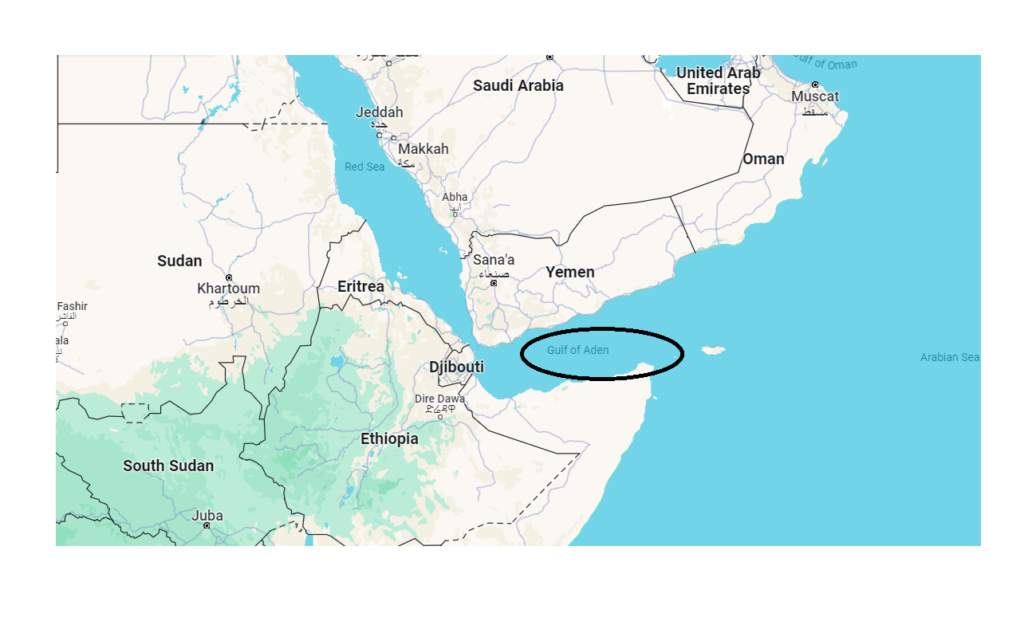Navigating the Gulf of Aden: Importance, Challenges, and the Latest Developments

Introduction Gulf of Aden:
The Gulf of Aden, situated between Yemen, Somalia, and Djibouti, has long been a strategic waterway connecting the Arabian Sea to the Red Sea. This deepwater gulf holds historical significance, witnessed by its mention in ancient Greek texts and its prominence in the trade routes of various civilizations. Today, it continues to play a crucial role in global trade, making it a focal point of geopolitical and economic interests. However, recent events, such as the attack on the US-owned commercial vessel Gibraltar Eagle by Houthi militants, underscore the challenges and risks associated with navigating this vital maritime corridor.
Geography and Historical Significance:
The Gulf of Aden is approximately 900 kilometers long, bordered by Djibouti, Yemen, Somalia, and the Arabian Sea. Its importance dates back to ancient times, with the Greeks considering it a vital part of the Erythraean Sea. Over the centuries, it became a significant trade route, connecting Ptolemaic Egypt and Rome with Classical India and China.
Economic Importance:
One of the key reasons the Gulf of Aden is in the news today is its role as part of the Suez Canal shipping route. Annually, around 21,000 ships traverse the gulf, facilitating the transportation of approximately 8% of the world’s trade, including over 12% of the global volume of oil transported by sea. Major ports along its shores, such as Aden, Balhaf, Djibouti City, and Bosaso, contribute to its economic significance.
Challenges and Security Concerns:
The Gulf of Aden has faced challenges throughout history, from piracy during the collapse of the Roman economy to the modern-day threats posed by Houthi militants. Piracy was a significant concern in the late 2000s, with attacks disrupting global trade. International efforts, including naval patrols and anti-piracy coalitions, have contributed to a decline in piracy incidents. However, recent events, such as the missile strike on the Gibraltar Eagle, highlight the persistent security risks in the region.
Environmental Concerns:
The Gulf of Aden boasts a unique biodiversity, with a variety of fish, coral, seabirds, and invertebrates. Despite this richness, environmental groups express concerns about pollution jeopardizing the gulf’s ecosystem. Overfishing and past illegal hunts, particularly by the Soviet Union and Japan in the 1960s to 70s, have impacted marine life. Efforts to control pollution and protect the region’s ecology remain critical.
The Recent Attack and Its Implications:
The Houthi missile strike on the Gibraltar Eagle in the Gulf of Aden raises alarms about the safety of one of the world’s most crucial trade routes. The attack comes amidst ongoing conflicts in Yemen, with Houthi militants targeting vessels connected to Israel. This has prompted warnings from the US and industry trade groups for ships to avoid the Red Sea, contributing to increased shipping costs and potential delays in global trade.
Conclusion:
The Gulf of Aden, with its historical significance and economic importance, remains a region of strategic interest. However, challenges like piracy, security threats, and environmental concerns pose risks to both maritime activities and the rich biodiversity of the area. The recent attack on the Gibraltar Eagle serves as a reminder of the complex dynamics in this region and the need for continued international cooperation to ensure the safe navigation of this vital maritime corridor.
| Instagram Page | Click Here |
| Go to Our Home Page | Click Here |
| Link For newsdigital24 Latest Job | Click Here |
| For our Facebook Page | Click Here |
